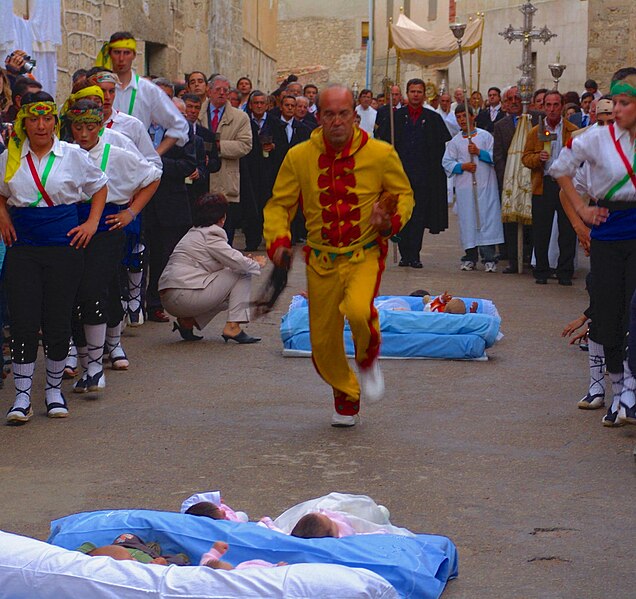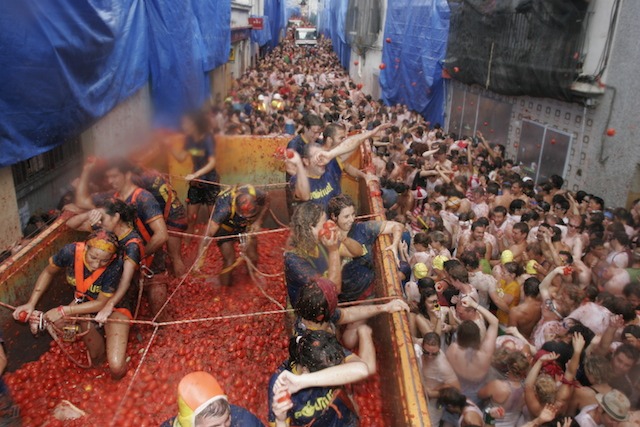Spain is rich in cultural past, with numerous odd customs and ceremonies. The Baby Jumping Festival, also known as “El Colacho” in Spanish, is a unique tradition. This bizarre ritual features mature men dressed as devils jumping over rows of babies sleeping on the ground. The celebration has been honored for generations and is thought to provide infants good luck and protection. If you want to understand more about this strange but intriguing practice, buckle up and join me on a journey to discover Spain’s Baby Jumping Festival’s history, importance, and cultural significance.
The Origins of El Colacho
The Baby Jumping Festival, also known as El Colacho, is a unique and peculiar event that has been celebrated for centuries in the small town of Castrillo de Murcia in northern Spain. While there are no official records of when the festival began, local historians believe it has occurred annually since at least the 1600s.
The Catholic Brotherhood of the Sacred Sacrament of Minerva is in charge of organizing the week-long festival to commemorate the Corpus Christi feast. The town is decorated with colorful flags and banners during the festival, and inhabitants assemble to enjoy traditional Spanish music, dance, and food.
The Salto del Colacho, held on the final Sunday of the festival, is the event’s high point. The Colacho, a man dressed as the Devil in colorful clothing and mask, travels through town with a whip, terrorizing villagers who respond with obscenities. This is merely a warm-up for the big event: baby jumping.
The Lore Behind El Colacho
The figure of the devil, or El Colacho, who is the principal character of the El Colacho festival, is at the core of the celebration. He is dressed in a colorful attire meant to convey his malevolent nature. His face is concealed by a yellow mask, and his only distinguishing feature is his eyes. He’s carrying a big castanet, which he plays to provide a loud and threatening sound that adds to the event’s atmosphere.
Throughout the festival, El Colacho is accompanied by El Atabalero, the drummer. He stands behind the devil, dressed in a long black coat and a top hat, and delivers the rhythmic beat that propels the celebration ahead. The two figures work together to create a dark and scary mood that is unique to this festival.
Surprisingly, the roles of El Colacho and El Atabalero are not always played by the same individuals. Instead, a handover ceremony is held to choose the next squad of performers, with two El Colachos presiding over the week-long event. El Colacho, who will jump over the babies at this year’s festival, is accompanied by his doppelganger, who will take on the duty the next year. The double is in charge of everything, ensuring that the event runs smoothly and that all of the ancient rites are carried out appropriately.
View this post on Instagram
How is Baby Jumping Performed
The “salto” or jump, which occurs when grown men costumed as demons jump over rows of babies lying on a mattress on the ground outside their homes, is one of the most peculiar features of this celebration.
All babies born in the town within the last year are considered for the jump, even if they are only a few weeks or days old. As onlookers cheer, the Colacho, who represents the devil, jumps over the infants. This rite is thought to purify the babies of their original sin, a concept in Christian theology that all humans bear as a result of Adam and Eve’s disobedience to God in the Garden of Eden.
While the religious significance of the festival is still recognized by some, it is also regarded as an important cultural festivity that contributes to the town’s heritage. Visitors worldwide come to witness this one-of-a-kind and old custom.
After the Colacho jumps over the babies, they are showered in rose petals and frequently blessed by the local priest before being collected by their parents. The major event is concluded, but the festival continues with music, dance, and feasting until late at night.
What Happens at the End of El Colacho?
After the devil has finished jumping over the infants, he bursts out of the church, running through the streets like a wild man. This frantic and chaotic spectacle is meant to symbolize the expulsion of evil and sin from the community. He is pursued by the locals, who cheer and jeer as they follow him out of town.
Following El Colacho’s departure, the final parade takes place, during which young girls and members of the brotherhood cover the babies with delicate rose petals. This rite is intended to complete the blessing and cleansing of the infants, who are now free of their original sins. It is considered that the babies have been purged of their sins and are now baptized and welcomed into the religious community.
View this post on Instagram
The Cultural and Spiritual Impact of El Colacho
El Colacho is a special occasion for the families of Castrillo de Murcia, who see it as a unique opportunity for their babies to be cleansed of their original sins. The babies’ parents go to great efforts to prepare for the rite, ensuring that the mattress is correctly laid out and that their children are dressed in their finest clothes.
The baby jumping custom is a vital method for many families to interact with their community and preserve their cultural history. The festival draws large groups of locals and visitors who come to see the spectacular show and join in the celebrations. Throughout the week-long celebration, there is music, dance, and street performances.
Parents watch with pride as their babies are blessed by the archbishop, knowing that their children have been cleansed of their original sins. It’s a joyful and celebratory event that will be remembered for years to come.
View this post on Instagram
Criticisms and Controversies
Despite its long history and cultural significance in Castrillo de Murcia, some Catholic authorities have criticized the El Colacho festival. Jumping over babies to cleanse them of their original sin is contrary to traditional Catholic customs and, as such, has been discouraged by some members of the Catholic Church.
Pope Benedict XVI has even directed Catholic priests in the area to refrain from participating, noting that it contradicts traditional Catholic teachings and practices. While many Catholics welcome babies into the religious community through baptism, which involves a priest blessing the child, the Baby Jumping Festival is seen as unconventional and controversial.
Despite the criticism, the town of Castrillo de Murcia has continued to celebrate the festival every year for over four centuries, keeping the tradition alive. The Baby Jumping Festival has grown into an important cultural event for the town, and it represents a distinct and fascinating piece of Spain’s rich cultural legacy for many people.
While the Catholic Church has not fully accepted the festival, its continued celebration demonstrates the power of tradition and the importance of cultural practices in shaping our understanding of the world around us. As long as the inhabitants of Castrillo de Murcia cherish the tradition and its importance, the Baby Jumping Festival will likely remain a part of their cultural identity for future generations.
La Tomatina: Another Strange Tradition in Spain
El Colacho isn’t the only odd ritual to see and experience in Spain. La Tomatina is another odd celebration that takes place every year on the final Wednesday of August in the small town of Buñol, which is located in the Valencia region of Spain. It’s a worldwide event known for the unique experience of thousands of people converging to throw ripe tomatoes at each other.
The morning festivities begin with the arrival of trucks loaded with ripe tomatoes in the town plaza. As soon as the signal is given, the throng begins hurling tomatoes at one another, turning the streets into a sea of red. The festival lasts about an hour, after which the streets are hosed off, and life returns to normal in the town.
Despite its popularity, La Tomatina has received criticism from a variety of sources, notably for food waste. Locals, however, maintain that the tomatoes used were of poor quality and would have been discarded regardless. Some locals have also objected to the festival, citing the mess caused by the tomato pulp and the large influx of tourists.
In recent years, the festival has enacted stringent measures to safeguard the safety of its attendees. The number of participants is limited, and objects other than tomatoes are not permitted to be thrown. It is also advised to wear protective equipment such as goggles and gloves.
In conclusion, the Spanish baby jumping festival is a unique picture of the conflict between good and evil, as well as a celebration of new life and religious ceremony. Jumping over the infants is viewed as a heroic deed meant to purify them of their sins and drive out any remaining evil from the town. Despite its contentious nature and the Catholic Church’s disapproval, this unusual and fascinating festival continues to attract and pique the curiosity of visitors from all over the world, and its traditions are expected to be maintained for many years to come.


